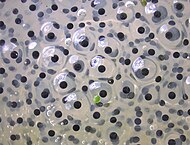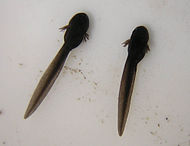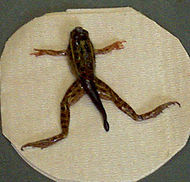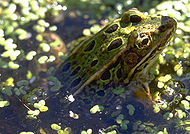Difference between revisions of "AY Honors/Life cycle of a frog/es"
(Created page with "Libro de Respuestas de Especialidades JA/Naturaleza/Ciclo de Vida de un Sapo") |
(Created page with "</noinclude> ===Ranas=== 190px|thumb|Huevos de rana 190px|thumb||10 días: Renacuajos Image:Frog-Zhe.jpg||190p...") |
||
| Line 1: | Line 1: | ||
<noinclude></noinclude> | <noinclude></noinclude> | ||
| − | === | + | ===Ranas=== |
| − | [[Image:Frogspawn closeup.jpg|190px|thumb| | + | [[Image:Frogspawn closeup.jpg|190px|thumb|Huevos de rana]] |
| − | [[Image:Tadpoles 10 days.jpg|190px|thumb||10 | + | [[Image:Tadpoles 10 days.jpg|190px|thumb||10 días: Renacuajos]] |
| − | [[Image:Frog-Zhe.jpg||190px|thumb|8–12 | + | [[Image:Frog-Zhe.jpg||190px|thumb|8–12 semanas: Rana joven]] |
| − | [[Image:Green-leopard-frog-in-swamp.jpg||190px|thumb|12–16 | + | [[Image:Green-leopard-frog-in-swamp.jpg||190px|thumb|12–16 semanas: Rana adulta]] |
| − | + | El ciclo de vida de las ranas, como la de otros anfibios, consta de cuatro etapas principales: huevo, renacuajo, metamorfosis y adulto. La dependencia de las ranas de un medio acuático para las etapas de huevo y renacuajo da lugar a una variedad de comportamientos de reproducción que incluye las llamadas de apareamiento que usan los machos de la mayoría de las especies para atraer a las hembras al agua para la reproducción. Algunas ranas también cuidan de sus huevos y, en algunos casos, cuidan los renacuajos. | |
The life cycle of a frog starts with an egg. Eggs are generally laid in water, and an individual female may lay egg masses containing thousands of eggs. While the length of the egg stage depends on the species and environmental conditions, aquatic eggs generally hatch within one week. | The life cycle of a frog starts with an egg. Eggs are generally laid in water, and an individual female may lay egg masses containing thousands of eggs. While the length of the egg stage depends on the species and environmental conditions, aquatic eggs generally hatch within one week. | ||
Revision as of 03:49, 5 May 2015
Ranas
El ciclo de vida de las ranas, como la de otros anfibios, consta de cuatro etapas principales: huevo, renacuajo, metamorfosis y adulto. La dependencia de las ranas de un medio acuático para las etapas de huevo y renacuajo da lugar a una variedad de comportamientos de reproducción que incluye las llamadas de apareamiento que usan los machos de la mayoría de las especies para atraer a las hembras al agua para la reproducción. Algunas ranas también cuidan de sus huevos y, en algunos casos, cuidan los renacuajos.
The life cycle of a frog starts with an egg. Eggs are generally laid in water, and an individual female may lay egg masses containing thousands of eggs. While the length of the egg stage depends on the species and environmental conditions, aquatic eggs generally hatch within one week.
Some frogs do not have the tadpole stage going from egg to adult shape e.g. New Zealand's native frogs (pepeketua) belong to the genus Leiopelma. Eggs hatch and continue life as tadpoles (occasionally known as polliwogs). Tadpoles are aquatic, lack front and hind legs, and have gills for brething and tails with fins for swimming. Tadpoles are typically herbivorous, feeding mostly on algae, including diatoms that are filtered from the water through the gills. Some species are carnivorous at the tadpole stage, eating insects, smaller tadpoles and fish. The tadpole stage may be as short as a week, or tadpoles may overwinter and metamorphosis the following year in some species, such as the Midwife toad (Alytes obstetricans) and the Common Spadefoot (Pelobates fuscus).
At the end of the tadpole stage, frogs undergo metamorphosis, in which they transition into adult form. Metamorphosis involves a dramatic transformation of body shape and function, as tadpoles develop hind legs and then front legs, lose their gills and develop lungs. Their intestines shorten as they shift from an herbivorous to a carnivorous diet. The final stage of development from froglet to adult frog involves the loss of the tail.
After metamorphosis, young adults may leave the water and disperse into terrestrial habitats, or continue to live in the aquatic habitat as adults. Almost all species of frogs are carnivores as adults, eating invertebrates such as spiders, insects, snails, and slugs. A few of the larger species may eat prey such as small mammals, fish and smaller frogs. Some frogs use their sticky tongues to catch fast-moving prey, while others capture their prey and force it into their mouths with their hands. However, there are a very few species of frogs that primarily eat plants. Adult frogs are themselves preyed upon by birds, large fish, snakes, otters, foxes, badgers, coatis, and other animals.




